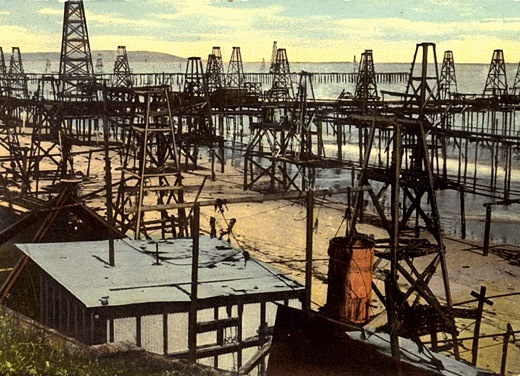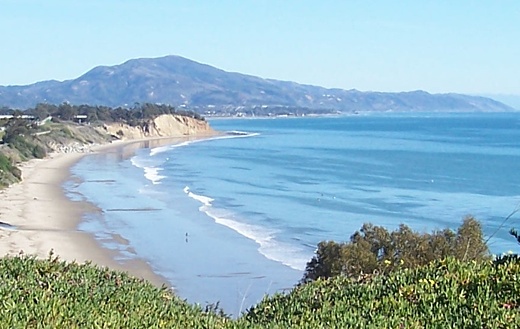 Image above: Summerland Beach in Santa Barbara, Califorina, early last century with on and off-shore oil drilling. From (http://www.image-archeology.com/california_oil_wells.htm)
By Chris Nelder on 5 March 2010 in Get Real List -
(http://www.getreallist.com/peak-demand-yes-but-not-the-nice-kind.html)
Image above: Summerland Beach in Santa Barbara, Califorina, early last century with on and off-shore oil drilling. From (http://www.image-archeology.com/california_oil_wells.htm)
By Chris Nelder on 5 March 2010 in Get Real List -
(http://www.getreallist.com/peak-demand-yes-but-not-the-nice-kind.html)
When oil crossed $120 a barrel for the first time in May 2008, oil cornucopians knew they were in trouble. Prices had quadrupled in just five years, yet had failed to bring new production online. Regular crude had flatlined around 74 million barrels per day (mbpd). The case for peak oil was looking stronger with every new uptick in crude futures.
The following month, prominent peak oil critic and cornucopian Daniel Yergin of IHS-CERA changed his stance: The peak oil threat would be neutralized by peak demand. Gasoline consumption had peaked in the U.S. and Europe, he argued, due to the combined effects of increasing efficiency, biofuels, and the recession.
In 2009 the peak demand story seemed confirmed, as prices stabilized around $70 in June, and U.S. consumption remained well off its previous high. Most people thought the nearly 2 mbpd decline in U.S. petroleum demand from 2007 through 2009 owed to efficiency and people driving less.
In reality, only about 15% owed to reduced gasoline demand. The other 85% was lost in the commercial and industrial sector: jet fuel, distillates (including diesel), kerosene, petrochemical feedstocks, lubricants, waxes, petroleum coke, asphalt and road oil, and other miscellaneous products.
Very simply, when oil got to $120 a barrel it cut into real productivity, and forced the world’s most developed economies to shrink. At $147, it wreaked serious damage.
As I explained in “Investment Themes for the Next Decade,” the new normal will be cycles of bumping our heads against the supply ceiling, falling dazed to the floor, rising back to our knees, then finally standing, only to bump our heads against the ceiling once more.
Scooters Will Kill SUVs
Two interesting news stories crossed the wire this week, which portend badly for the world’s #1 net oil importer, the U.S.
The first was a Reuters report that the last quarter of 2009 had “wiped out” the equity of Mexican state oil monopoly Pemex, leaving it $1.4 billion in the negative. Falling crude output, falling refining margins and a burgeoning dependency of the state on its revenues had squeezed it to death.
Not only did the report offer further confirmation that the oil export crisis has arrived, but it also confirmed my growing suspicion that the oil production everyone has assumed will come online in five to ten years might, in fact, fail to materialize. Negative equity companies have a hard time raising capital for new exploration.
The second was a Bloomberg report that Saudi Arabia had agreed to double its oil exports to India, to some 866,000 barrels per day. India indicated separately that its onshore production of oil may peak this year.
This adds to the pressure on Saudi Arabia’s exports, whose oil shipments to China have been growing at a rate of 11-12% per year and now stand at roughly 1 million barrels per day (mbpd). China has eclipsed the U.S. as the primary bidder for Saudi oil, while U.S. imports from the Persian nation have fallen to a 22-year low.
The last two years have seen the marginal buyers of oil shift decisively to the non-OECD countries. A gallon of fuel delivers so much value in China and India–think of peasants on scooters–that even at $120 a barrel, remarkable economic growth rates are possible. In major oil exporting countries like Saudi Arabia and Venezuela, where subsidized gasoline still sells for under 25 cents a gallon, the appetite for fuel grows steadily every year with little thought given to efficiency.
It’s a different story in the U.S. For debt-laden consumers, an extra $50 or $75 to fill up the tank on an SUV every month sharply reduced discretionary income and starved the economy of its most fundamental driver, consumer demand.
‘Peak Demand,’ Yes, But Not the Nice Kind
The most promising effort I’ve seen to quantify the role of efficiency in peak demand was a report in October of last year by Paul Sankey of Deutsche Bank entitled, “The Peak Oil Market.” My initial excitement quickly gave way to disappointment as dug into it, however, as I realized that its confident assertions were unsupported by the data. I applauded the effort enthusiastically–and I hope to see more serious work along the same lines–but it fell far short of proving that energy transition can be accomplished under the status quo of economic growth, let alone its optimistic twist on “The end is nigh for the age of oil.”
 Image above: Summerland Beach, in Santa Barbara, California, as it appears today. Being past ERoEI is not so bad, is it? From (http://www.larry93014.com/headers.htm)
Image above: Summerland Beach, in Santa Barbara, California, as it appears today. Being past ERoEI is not so bad, is it? From (http://www.larry93014.com/headers.htm)
The fact is that peak demand in the OECD is not merely a function of efficiency gains and biofuels substitution, aided by a temporary recession.
Instead, peak demand will be the result of a permanent state of increasing depression in which non-OECD countries not only more than make up for the loss of OECD demand, but outbid them for the marginal barrel.
As we enter the post-peak phase of global oil supply sometime around 2012-2014, the price that heavily import-dependent countries like the U.S. would have to pay for that marginal barrel will become increasingly intolerable. In a weakened economy, $100 a barrel (or less) could be the new $120.
The true import of peak oil, therefore, may not be sustained high prices, but economic shrinkage. Demand will be destroyed long before oil gets to $200 a barrel, but it will not be destroyed by improved efficiency.
From where we stand today, it’s hard to make an argument for economic recovery. Persistently high unemployment rates, broken state and federal balance sheets, and an inflationary depression will continue to cut into petroleum demand. We spent the last several decades offshoring the fundamental value-adding sectors like energy production and manufacturing, and now our FIRE economy (finance, insurance, and real estate) rests entirely on real value created elsewhere.
The reason is simple: Energy is the only real currency. Every dollar of fiat currency or GDP was ultimately derived from cheap energy. Trying to print your way out of energy decline is like prescribing ever-higher doses of aspirin for a headache caused by a brain tumor. Yet those at the levers of monetary policy are, by all appearances, completely ignorant (or in willful denial) of this fundamental fact.
The vogue prescription for the sovereign debtors at greatest risk of default (see a Top 10 list here) is “austerity measures.” The theory is that a period of belt-tightening will stanch the fiscal bleeding until economic recovery puts everyone into the black again.
Yet, if primary energy supply is declining, and the rising star of developing economies is inexorably cutting into the supply available to developed and indebted economies, then there can be no recovery.
I have joked on Twitter that I’m expecting an “M-shaped recovery,” where we’re now on the second hump. A more accurate image is slow strangulation.
The Real Meaning of Peak Demand
Those who would argue for economic recovery must answer two intractable questions.
The question first is: Where will the energy come from, as more of the world’s net exporters become net importers?
Britain, Argentina, Indonesia, and others have become net importers in recent years. Mexico and Columbia are expected to follow suit within a decade. Clearly, we can’t all be net energy importers.
There is also the obstinate fact that aggregate net energy – or the energy returned on energy invested (or ERoEI) to get oil produced–has been dropping steadily. Oil net energy dropped from 100 in the early 1930s to 11 or less today. Net energy for natural gas is now in decline. We don’t have adequate data to know yet, but coal’s net energy is probably in decline too. Meanwhile, the net energy of all substitutes is low: wind, 18; solar, 6.8; nuclear, 5-15; all biofuels, under 2.
It is not surprising that a study of the Herold database (Gagnon, Hall, and Brinker, 2009) showed the amount of oil and gas produced per dollar spent declined between 1999 and 2006.
The second question is: If the creeping infection of sovereign default continues to spread to more countries, where will the money come from to bail them out? The answer has been, and continues to be, more aspirin. Without more cheap energy, monetary tactics to play the game into overtime will not only be futile, they will only draw us closer to the edge of the net energy cliff.
All of which begs a final question: If the answers are transition to renewables, and rebuilding our infrastructure for high efficiency, then where will the money and energy to do it all come from? And how long will it hold out?
Without cheap energy to fuel the growth that is hoped to pay off the accumulated debt, austerity will become an everyday reality, not a short-term fix. A reality that slowly sinks in for the rest of our lives, as net importers become progressively poorer.
The peak demand argument is a good one–but not for the nice reasons.
.
1 comment :
Looking at the key quotient, in 'net-return,' your assessments read like Gerald Celente's dire economic forecasts; can someone explain the meaning of a 'Jobless' recovery... (?)
BTW, Mainlanders know little to nothing about Hawaii, and were it not for the recent 'tsunami' scare, few of us would have even remembered our 50th State. It doesn't help that DOLE behaves like DOW, and these other unaccountable multi-nationals, and it saddens me to think of any island nation being strangled in the form of a prolonged recession.
Post a Comment